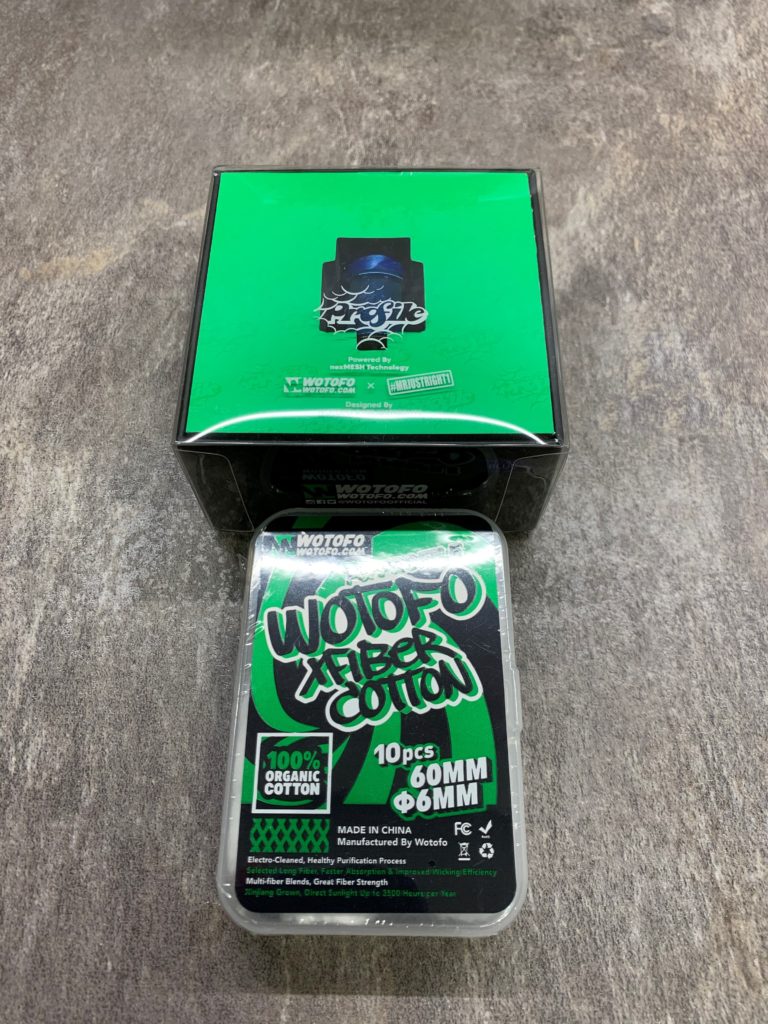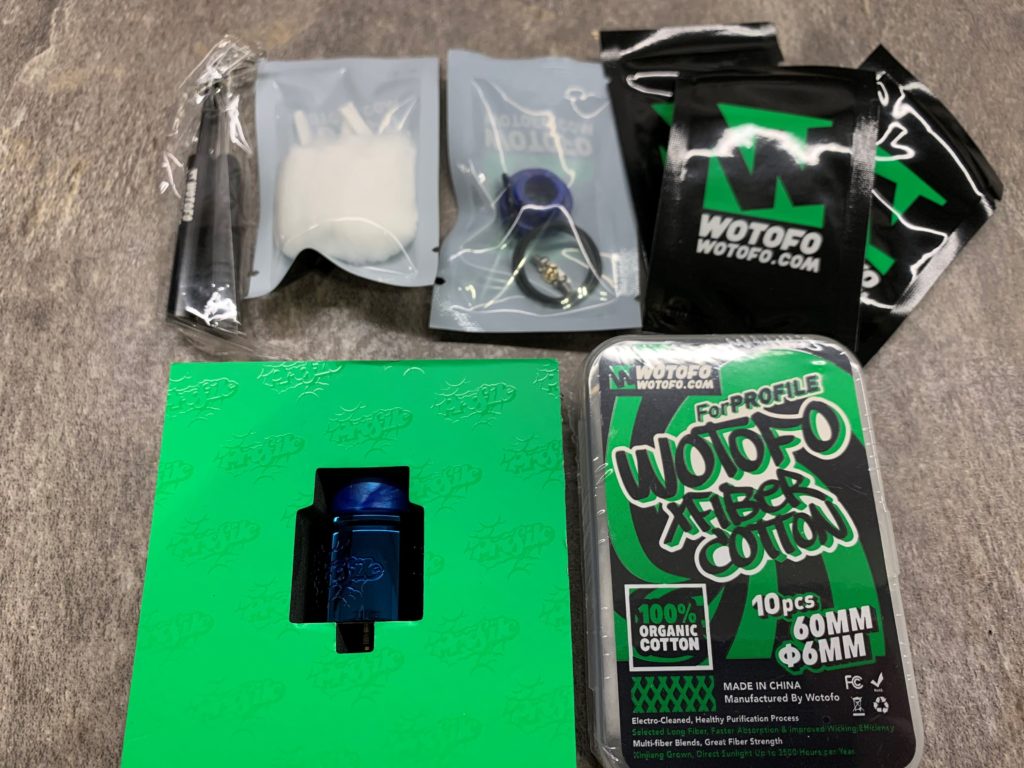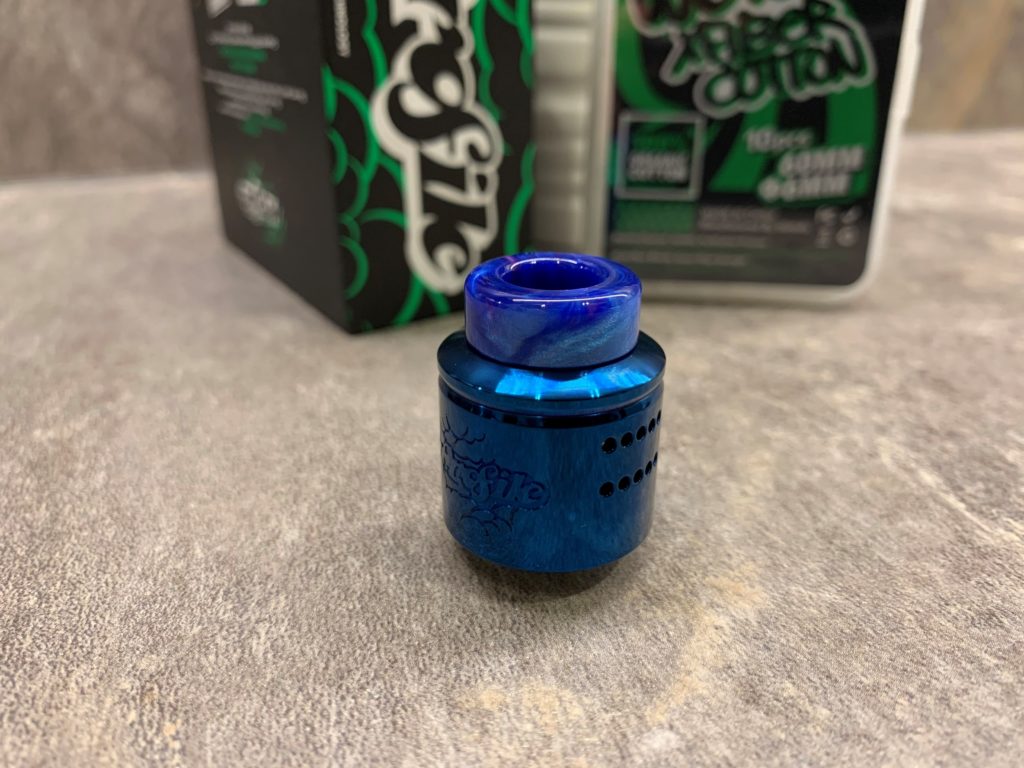Wotofo Profile 1.5 Review – Amazing RDA in Town!

The Profile 1.5 brought rebuildable mesh atomizers back in existence and topped pretty much every best RDA list due to its innovative design and great performance. Presently Wotofo cooperates again with Mr JustRight1 for the second RDA in the Profile line, the Profile 1.5. It is a 24 mm squonk-first RDA, with a series of updates that range from minor to huge. Did the world need a 1.5 version of the Profile RDA?
First, let’s find out what is inside the box!

- 1 x Profile 1.5 RDA
- 1 x User manual
- 1 x Extra drip tip
- 1 x Bending tool
- 1 x Accessory bag
- 1 x Allen key
- 1 x Cross head screwdriver
- 3x Thick X-fiber 6 mm cotton strip
- 1 x nexMESH CHILL A1 0.15 ohm
- 1 x nexMESH TURBO A1 0.13 ohm
- 1 x nexMESH EXTREME A1 0.16 ohm
Assembled Quality and Design
Noticing the RDA completely assembled, outside of the airflow, very little seems to have changed from the principal version. The little hole between the airflow control top and the chamber top has been removed, making the 1.5 version appx. one mm shorter, and the logo looks more cartoony now. Be that as it may, until you remove the top, the two atomizers look really like each other.
Once the top is off, the differences between the two form decks are self-evident. The 1.5 edition comes with a lot larger deck and overall space, and the manner in which they accomplished that is by making the top altogether thinner. The juice well is additionally shallower now, and the two-deck O-rings of the first have been replaced by a single thicker one. As a result, the top of the 1.5 can be removed a lot easier this time around. In any case, make sure you lube everything up with some VG for even better results. I like the way that Wotofo decided to include a position of safety dribble tip as a second choice. I am not the biggest aficionado of these trickle tips as my lips often end up contacting the top—which for reasons unknown consistently happens after I have been chain-vaping for some time. Be that as it may, I realize some people love them, and having choices is far superior to having one more of the same.
Overall form quality and machining are really acceptable, and I have no bad things to say whatsoever on that front. The main minor issue is that the hole of the locking mechanism on the deck is a small piece excessively long, which means that the top feels somewhat shaky laterally. In any case, that is a nitpicky con and the vast majority won’t even notice it.

Fabricate deck
The larger size of the deck on the 1.5 edition makes it a lot easier to work with, both for building and wicking. The braces are not spring-loaded, however, they are mounted at an angle and will easily move to the sides when unscrewing the deck screws. The ceramic piece that helps your wick from getting mushed now comes with a stiffer spring, and furthermore features some vertical ridges that ought to be able to channel e-liquid easier to the sides. The mesh strips available for the Profile 1.5 measure at 17 mm by 8.5 mm. They are a reasonable piece larger than the ones of the first—you could have a go at utilizing the older strips, however, you’ll need to use substantially less cotton as you will end up with coils that have a smaller ID. There’s absolutely no chance you’re going to fit these huge cotton pieces in the old strips, and there’s a chance that the flavour will suffer as well. I didn’t bother attempting it, however, you can give it an attempt if that is the main thing you have to work with.
Note that Profile 1.5 is used as a standard, non-mesh coil RDA. I personally don’t see quite a bit of a reason to do as such, and there are obviously better RDAs out there for that, so I might be talking about meshworks in the accompanying section.
Building and wicking
If you have used the first, expanding on the 1.5 edition will be a breeze. In any case, on the off chance that you haven’t manufactured a mesh RDA before, here’s a more-detailed-than-common guide to building and wicking the Profile 1.5. Take a mesh strip and move it on the thicker side of the included coiling pole, to give it a rounded, semi-circle shape. Then unscrew the two-deck screws, place the mesh strip on the one clip and secure it in place. Repeat on the other side, and check that your coil has a nice round shape to it. If not, you can use the thinner side of the pole to shape it up.
Once you are done, I suggest terminating the coil at around 20 watts, to check for hotspots and even heating. Mesh generally should work out of the crate, however, it doesn’t damage to make sure—and you’ll additionally clean it up a piece. In the event that you notice any hotspots, gently strum the strip with a couple of ceramic tweezers. Then take one of the included cotton pieces and pass it through the mesh strip, marginally pushing the ceramic part downwards. This is where the design updates begin to show their effects: the cotton strip fits a lot easier inside the mesh, and you don’t need to brush it meticulously and spend a lot of time giving it a hairstyle. Cut the ends at an angle leaving the base section somewhat longer, hanging approximately 2-3 mm outside of the deck. Somewhat brush it in the event that you feel like it, and gently fold your cotton inside the juice well beginning from the base. Easy-peasy.
It is very significant that you saturate the wick properly before terminating the mesh strip; you don’t need a consumed hit out of this RDA, I can promise you that. The best path is to trickle, pause, repeat—you may likewise need to put the chamber top on to abstain from getting juice on your mod. Then trickle or squonk and fire at a low wattage, and repeat in any event a couple of times. Once your cotton is completely wet, you can go on and raise the wattage.
Airflow
The airflow of the Profile 1.5 has likewise received some updates, however, there’s nothing super-groundbreaking here. The three columns containing 19 modest honeycomb holes of the first have been replaced by two lines containing 10 holes that are appx. half bigger. The top line is channelled through a very marginally angled space that is supposed to guide the air on the highest point of your construct—more on that later on. Interestingly, while the entirety of the diameter of the holes seems to be somewhat smaller, the 1.5 feels like an airier RDA when compared to the first.
Turning the top piece of the RDA takes into account airflow adjustment; you can restrict the airflow beginning from the top, and after it is completely closed you can begin shutting the base column. As a third alternative, the two lines can be closed vertically, in spite of the fact that you won’t be able to modify the top and the air might be hitting some portion of your assemble. There’s no real way to close the base and keep the top line, however as you will read in the accompanying section, that wouldn’t be of a lot of use in any case.
Wotofo Profile 1.5 Performance
To test performance, I tried every one of the three included mesh strips.
- nexMESH CHILL A1 0.15 ohm, rated for 60-80 watts
- nexMESH TURBO A1 0.13 ohm, rated for 60-80 watts
- nexMESH EXTREME A1 0.16 ohm, rated for 60-80 watts
The CHILL is designed like the Wotofo mesh for the first Profile, the TURBO is modelled after the older nexMESH strips, and the EXTREME is a standard, outdated type mesh strip without the level parts at the ends. As indicated by Wotofo, the three strips are supposed to perform differently, and that is true to an extent. The differences are not striking, however, they are there. Used at 80 watts, the CHILL strip is a somewhat cooler vape, the TURBO is warmer and delicious, and the EXTREME is the warmest, with comparable flavour to the TURBO.
Bear as a primary concern that every one of the three strips performed fine at 90 watts and you can easily get 6-7 pulls before trickling or squonk. Simply make sure you give it some time in between, as chain-vaping at these wattages will make it pretty warm. That is a significant upgrade over the first, which often seemed to struggle at the higher end of the recommended wattages. With the strips performing equivalently, what ends up having a bigger effect in enhance is the airflow. I don’t like off-setting my airflow, so I generally tested the RDA in two airflow designs: completely open and base column open. With the base column open, I get a smooth restricted DL vape with slamming flavour—my cream-based juices taste absolutely great on this RDA. Opening up the top column mutes the flavour essentially and makes me feel that the angle of the air flow space isn’t steep enough to guide the air to the coils. It isn’t so much that the flavour is terrible when completely open, yet there’s really no examination between the two airflow choices.
As I mentioned in the introduction, Profile 1.5 is an RDA made for squonking—or an RSA maybe. You can use it as a dripper, yet you should trickle very often and take care not to flood the deck. Its squonking system is designed very carefully, and I advise utilizing it as a dripper just if all else fails.
| Positives | Negatives |
| Great form quality | Offset airflow when top and base are halfway closed |
| Better O-ring tolerances than the first | Somehow unstable due to the long bolting score |
| Ample deck space | No TC-compatible mesh strip |
| Redesigned ceramic piece | Need to trickle often if not used as a squonk |
| A lot easier to manufacture/wick compared to the first | |
| Can likewise be used with regular coils | |
| Three available mesh strip alternatives | |
| Wide range of power | |
| Smooth airflow | |
| Great flavour with the top line closed | |
| Numerous accessories (counting a position of safety trickle tip) |
Summary
Unlike many people, I am a fanatic of 1.5 editions of famous items. Truth be told, I feel that numerous V2s are really V1.5s, best-case scenario, and seeing 1.5 makes me feel that the designers are sincere. Furthermore, that is exactly the case with the Profile. This edition of the Profile is better than the first from multiple points of view. It beats the first in assembling quality, versatility, and flavour performance—despite the fact that for the last part you’ll need to restrict the airflow a reasonable piece. What’s more, by enlarging the base and fabricated deck, Wotofo made the Profile 1.5 an a lot easier RDA to work with as well.







